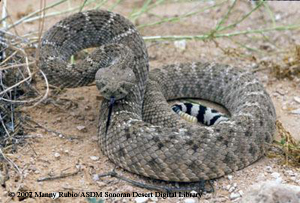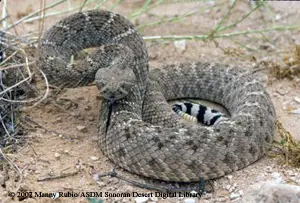Diamondback rattlesnakes are one of the most fascinating and dangerous creatures on the planet. These venomous snakes are known for their distinctive rattles and diamond-shaped patterns on their skin. However, one question that often comes to mind is, how long do diamondback rattlesnakes live?
The lifespan of diamondback rattlesnakes varies depending on various factors, such as their environment and diet. While some may live up to 20 years, others may only live up to 10 years. Join us as we explore the intriguing world of diamondback rattlesnakes and uncover the secrets of their lifespan.
Diamondback rattlesnakes can live up to 20-25 years in the wild. However, few survive beyond 12 years due to various factors including predation, habitat loss, and hunting. These venomous snakes are found in North, Central, and South America and are known for their distinctive rattling sound that warns potential predators of their presence. They typically reach maturity at around 3-4 years of age and can grow up to 7 feet in length. Despite their intimidating reputation, diamondback rattlesnakes play an important role in controlling rodent populations in their ecosystems.

How Long Do Diamondback Rattlesnakes Live?
Diamondback rattlesnakes are one of the most iconic species of venomous snakes in North America. These reptiles can be found in a variety of habitats across the continent, from deserts and grasslands to forests and wetlands. But how long do diamondback rattlesnakes actually live? In this article, we will explore the lifespan of these fascinating creatures and the factors that influence their longevity.
1. The Average Lifespan of Diamondback Rattlesnakes
Diamondback rattlesnakes have a lifespan of 10-20 years in the wild. However, some individuals have been known to live up to 30 years. The lifespan of a diamondback rattlesnake depends on several factors, including genetics, environment, and food availability.
Genetics plays a significant role in determining how long a diamondback rattlesnake will live. Some individuals may be genetically predisposed to live longer or shorter lives than others. The environment also has a significant impact on the lifespan of these snakes. Diamondback rattlesnakes that live in harsh environments such as deserts may have a shorter lifespan than those that live in more temperate regions.
Food availability is another important factor that influences the lifespan of diamondback rattlesnakes. These snakes are carnivorous and feed on rodents, birds, and other small animals. If food is scarce, diamondback rattlesnakes may not be able to obtain enough nutrition to support their long-term survival.
2. Factors That Influence the Lifespan of Diamondback Rattlesnakes
There are several factors that can influence the lifespan of diamondback rattlesnakes. These include habitat loss, predation, disease, and human activity.
Habitat loss is a significant threat to the survival of diamondback rattlesnakes. As more and more land is developed for human use, the natural habitats of these snakes are being destroyed. This can lead to a decline in food availability and an increase in predation, both of which can lower the lifespan of diamondback rattlesnakes.
Predation is another significant threat to the survival of diamondback rattlesnakes. These snakes are hunted by a variety of predators, including birds of prey, coyotes, and other snakes. In addition, humans may intentionally kill diamondback rattlesnakes out of fear or as a form of pest control.
Disease is also a significant threat to the survival of diamondback rattlesnakes. These snakes can be infected by a variety of parasites and pathogens, including ticks, mites, and viruses. In some cases, disease can lead to death or a significant reduction in lifespan.
Human activity is another factor that can influence the lifespan of diamondback rattlesnakes. These snakes may be accidentally killed by vehicles or intentionally killed by humans who perceive them as a threat. In addition, activities such as logging, mining, and oil and gas development can destroy the natural habitats of diamondback rattlesnakes, leading to a decline in their population and lifespan.
3. Benefits of Diamondback Rattlesnakes
Despite their fearsome reputation, diamondback rattlesnakes play an important role in their ecosystem. These snakes help to control rodent populations, which can be a significant problem for farmers and homeowners. In addition, diamondback rattlesnakes are a source of food for a variety of predators, including birds of prey and other snakes.
In some cultures, diamondback rattlesnakes are also used for medicinal purposes. The venom of these snakes contains proteins that have been shown to have anticoagulant and anti-inflammatory properties. However, it is important to note that the use of snake venom for medicinal purposes should only be done under the guidance of a trained medical professional.
4. Diamondback Rattlesnakes vs. Other Rattlesnake Species
Diamondback rattlesnakes are one of several species of rattlesnakes found in North America. Other species include timber rattlesnakes, western rattlesnakes, and pygmy rattlesnakes. Compared to these other species, diamondback rattlesnakes are generally larger and have a more potent venom. However, the lifespan of these snakes is similar to that of other rattlesnake species, with an average lifespan of 10-20 years in the wild.
5. Conclusion
In conclusion, diamondback rattlesnakes have a lifespan of 10-20 years in the wild, with some individuals living up to 30 years. The lifespan of these snakes depends on several factors, including genetics, environment, and food availability. Habitat loss, predation, disease, and human activity are significant threats to the survival of these snakes. Despite their fearsome reputation, diamondback rattlesnakes play an important role in their ecosystem and have been used for medicinal purposes in some cultures.
Frequently Asked Questions
Learn about the lifespan of Diamondback Rattlesnakes through these commonly asked questions.
What is the average lifespan of Diamondback Rattlesnakes?
The lifespan of Diamondback Rattlesnakes varies depending on their habitat and the availability of food. Generally, they live for about 10 to 20 years in the wild. However, some Diamondback Rattlesnakes in captivity have been known to live up to 30 years.
Factors that contribute to the lifespan of Diamondback Rattlesnakes include their exposure to predators, parasites, and diseases. In addition, the availability of food and water can also affect their lifespan.
What is the oldest recorded age of a Diamondback Rattlesnake?
The oldest recorded age of a Diamondback Rattlesnake is 31 years. This particular snake was kept in captivity and was well taken care of by its owners. In the wild, Diamondback Rattlesnakes rarely live beyond 20 years due to various environmental factors.
It’s important to note that keeping Diamondback Rattlesnakes in captivity requires a lot of expertise, as they are venomous and can be dangerous if not handled properly.
How does the environment affect the lifespan of Diamondback Rattlesnakes?
The environment has a significant impact on the lifespan of Diamondback Rattlesnakes. These snakes prefer to live in dry and arid regions with rocky terrain and low vegetation. They are also found in deserts, grasslands, and forests. In areas where the environment is harsh, the lifespan of Diamondback Rattlesnakes is shorter.
In regions where they are at risk of predation or habitat destruction, their lifespan is also shorter. Human activities such as habitat destruction, pollution, and poaching are some of the threats that Diamondback Rattlesnakes face in their natural habitat.
What are the common causes of death for Diamondback Rattlesnakes?
Diamondback Rattlesnakes face various challenges in the wild that can lead to their death. Predation is one of the most common causes of death, with larger predators such as birds of prey and mammals feeding on them. Parasites and diseases can also cause their death.
Human activities such as habitat destruction, pollution, and road accidents are also major threats to their survival. In addition, Diamondback Rattlesnakes are often killed by humans due to their venomous nature and perceived threat to human life.
What is the significance of Diamondback Rattlesnakes in their ecosystem?
Diamondback Rattlesnakes play an important role in their ecosystem as they help to control rodent populations. They are also prey for larger predators, which helps to maintain a balance in the food chain. Additionally, their venom has medicinal properties that are used to treat various ailments.
However, Diamondback Rattlesnakes are also threatened by habitat destruction, climate change, and human activities. It’s important to protect these snakes and their habitat to ensure their continued survival and the health of their ecosystem.
Big Bad Eastern Diamondback Rattlesnake’s First Feeding (MUST SEE!!!)
In conclusion, the lifespan of a Diamondback Rattlesnake is a fascinating topic for anyone curious about these creatures. With an average lifespan of 10-20 years in the wild, these snakes have adapted to their environment with remarkable survival skills.
While they may be seen as dangerous predators, the Diamondback Rattlesnake plays an important role in the ecosystem, helping to control rodent populations and maintaining a balance in nature.
Overall, understanding the lifespan of Diamondback Rattlesnakes can help us appreciate their unique characteristics and the importance of preserving their habitat. By respecting these creatures and their environment, we can ensure that future generations can also enjoy the beauty and wonder of these amazing snakes.


